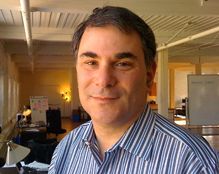 I have been thinking about regeneration. While it is common knowledge, it still amazes me, that salamanders can regenerate body parts, including their tails, upper and lower jaws, eyes and hearts. Yet mammals including humans can’t. Salamanders are the highest order of animals capable of regeneration. Do mammals know something that salamanders don’t? Cosmetic surgery, implants, and promising regenerative medicine research aside we humans are stuck with the body parts we are dealt for now.
I have been thinking about regeneration. While it is common knowledge, it still amazes me, that salamanders can regenerate body parts, including their tails, upper and lower jaws, eyes and hearts. Yet mammals including humans can’t. Salamanders are the highest order of animals capable of regeneration. Do mammals know something that salamanders don’t? Cosmetic surgery, implants, and promising regenerative medicine research aside we humans are stuck with the body parts we are dealt for now.
I wonder if our inability to regenerate at the biological scale also impedes our ability to regenerate at a social system scale. It seems obvious that our important social systems including education, health care, and energy need serious regeneration. These systems have evolved over a long period of time, were built to support an industrial era that is long gone, and have built up incredible mechanisms to resist and prevent needed change. It is not technology that is getting in the way of social system change. It is humans and the organizations we live in that are both stubbornly resistant to change. Why are humans so incapable of regeneration at both biological and social scales?
Maybe understanding the biology of regeneration can provide insight. Salamanders can regenerate injured body parts because evolution has enabled them to immediately unleash stem-like cells to a wound site when damage is detected. When salamanders are wounded skin, bone, muscle, and blood vessels at the site revert to their undifferentiated state. In essence they go back to an embryonic state and start all over again making regeneration possible. Humans took a different evolutionary path.
Turns out the human evolutionary pathway traded off regeneration in favor of tumor suppression. In order to decrease the risk of cancer and increase longevity our mammalian ancestors selected against regeneration. The theory is rapid cell division required for regeneration looks to our bodies a lot like the unchecked growth of cancer. Because our longevity makes us vulnerable to accumulated DNA mutations we’ve evolved a kind of molecular brake to keep tumors at bay. I can’t speak for humankind but it seems like the right trade-off to me. Unlike salamanders, when mammals lose a limb the body’s reaction is to release cells to the site that become scar tissue. Current stem cell research is promising and offers the future potential for a work-around to enable regeneration without turning off the molecular brake that prevents tumor formation and progression. Tissue generation and regenerative medicine are both exciting fields to watch.
I think there are parallels at a social system scale. Social systems have also evolved selecting for traits that maximize longevity. Our current education, health care, and energy systems are well intentioned and pedaling very hard to deliver value. The truth is these systems are no longer positioned to deliver value the way we want and need them to. We all know there is a better way. The 21st century screams for system regeneration and yet the best we seem to be able to do is tweak current models and to leverage technology in a sustaining way to coax more life out of systems that are not sustainable. The evolutionary pathway for our current social systems seems to have traded off regeneration in favor of innovation suppression. I know it seems extreme to equate innovation to a cancerous cell in an organization or social system. But hey, I have seen and worked in many organizations and systems, in both the public and private sectors, which have built up incredible defenses to insulate and protect themselves from innovation and change. Tell me you haven’t experienced the same thing? Our social systems have evolved antibodies to attack and wear down innovators. Organization and system leaders fear metastasis of disruptive technologies and seeds of change. They have established an armamentarium of tools to resist and block regeneration.
We don’t need more tweaks. We need system regeneration. Just like tissue engineering and stem cell research is opening up the possibility of regeneration at a biological scale we need to leverage social media and purposeful networks of innovators to enable regeneration at a social system scale. We must design, prototype, and test new systems solutions in the real world to determine what works and can scale. Student, patients, and citizens are waiting. Let’s unleash the newt within.









Leave a Reply